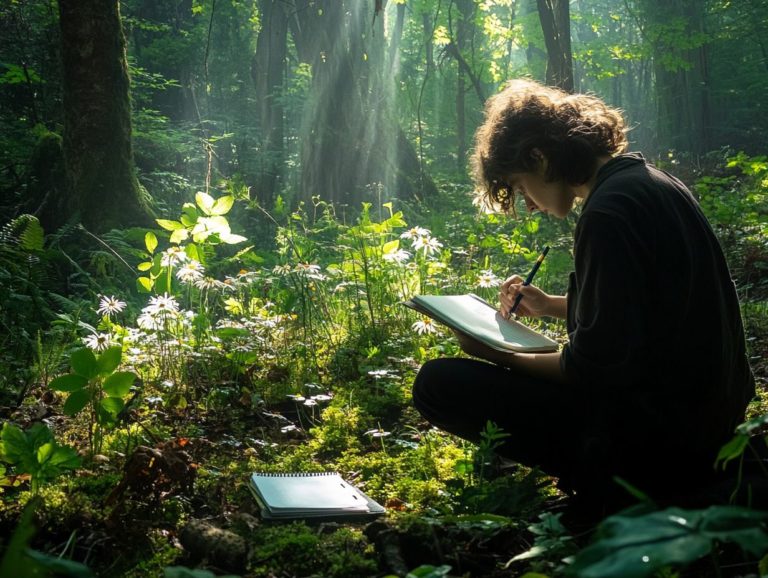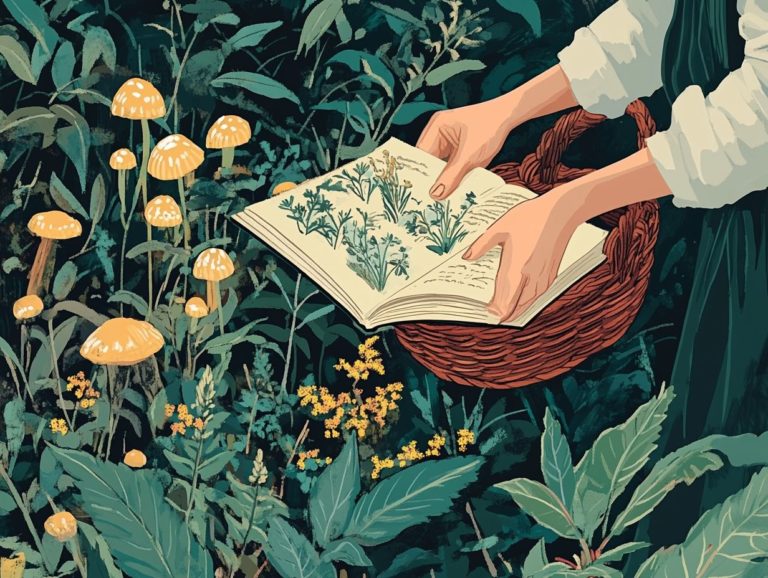Foraging Techniques for Wilderness Survival
Foraging transcends mere survival; it opens a pathway to a deeper understanding and connection with the natural world.
This article delves into the essentials of foraging, guiding you through the identification and safe consumption of edible plants and fungi, as well as the art of hunting and trapping for food sourcing.
You ll learn how to locate and purify water, ignite a fire for cooking, and navigate using natural landmarks each skill vital for thriving in the wild.
Dive into foraging now to elevate your wilderness skills!
Contents
- Key Takeaways:
- Edible Plants and Fungi
- Hunting and Trapping for Food
- Water Sources and Purification Methods
- Fire Building and Cooking in the Wild
- Creating and Maintaining a Fire for Cooking
- Navigation and Shelter Building
- Using Natural Landmarks and Materials for Navigation and Shelter
- Frequently Asked Questions
- What are foraging techniques for wilderness survival?
- Why is it important to know foraging techniques for wilderness survival?
- What are some essential tools for foraging in the wilderness?
- How can I identify which plants are safe to eat while foraging in the wilderness?
- Are there any foraging techniques that can help minimize my impact on the environment?
- Can I forage for meat in the wilderness?
Key Takeaways:

- Foraging is crucial for survival in the wilderness.
- Learn to identify and safely consume wild plants and fungi.
- Hunting, trapping, and fishing provide protein-rich food.
What is Foraging and Why is it Important?
Foraging is the art of searching for and gathering wild edibles, including both plants and fungi. It plays a vital role in enhancing survival skills and living off the land. By exploring top foraging techniques for beginners, you can forge a meaningful connection with nature, discover alternative food sources, and enrich community learning, all while diversifying your nutritional options.
By understanding the nutritional value of wild edibles, you deepen your appreciation for the environment and your place within it.
This ancient skill, honed by our ancestors over millennia, is enjoying a renaissance among modern enthusiasts like you who seek a more intimate relationship with the earth. Foraging cultivates an appreciation for biodiversity and nurtures sustainable practices within communities.
Participating in workshops and foraging groups offers an invaluable platform for knowledge sharing. You can exchange stories and hone skills related to gathering wild plants, identifying edible plants, and understanding local ecosystems. Such community engagement ensures that the treasured knowledge of wild edibles is preserved and passed on to future generations.
Edible Plants and Fungi
Edible plants and fungi are essential elements of foraging. They deliver essential nutritional value and a rich tapestry of flavors that can elevate your culinary ventures.
Wild edibles, including dandelions and elderberries, as well as an array of wild mushrooms like Chicken of the Woods and puffballs, present a plethora of options for those who master the art of foraging.
Grasping the nuances of identifying these plants and knowing the right seasons for harvesting is vital for anyone who aspires to embrace sustainable living.
Identifying and Safely Consuming Wild Plants
Identifying and safely consuming wild plants is an essential part of foraging that demands both knowledge and skill. Utilizing resources like the Peterson Field Guide can help you distinguish between edible plants and their toxic lookalikes, ensuring a safer foraging experience.
Understanding the nutritional value and medicinal properties of various wild edibles enables you to make informed decisions about what you consume.
Immersing yourself in local foraging communities can be incredibly beneficial. Experienced foragers share invaluable insights and personal experiences. Engaging in hands-on workshops or guided foraging walks provides practical knowledge, reinforcing the lessons you’ve learned from books.
It s crucial to familiarize yourself with the environment you’re exploring. Factors like soil quality and season can greatly influence a plant’s edibility. Paying attention to a plant’s characteristics such as leaf shape, flower color, and habitat can significantly enhance your identification skills.
Ultimately, prioritizing safety measures, including proper cooking methods and portion sizes, will lead to a rewarding and nutritious foraging experience.
Get started today and discover the bounty of the wild!
Hunting and Trapping for Food

Hunting and trapping for food is an essential survival technique that beautifully complements foraging. By incorporating foraging techniques from around the world, you can gather a diverse array of nutritional options, from wild game to edible insects.
Mastering these skills is vital for anyone seeking self-sustainability, as they provide insights on how to use foraging techniques in cooking and offer alternative food sources in survival situations.
With the right survival gear and a solid understanding of local wildlife, you can dive into hunting and trapping methods that will elevate your foraging experience, including foraging techniques for a sustainable future.
Tools and Techniques for Catching Game
Using the right tools and techniques for catching game is essential for effective hunting and trapping. This significantly enhances your survival skills.
From snares to bows, various tools help in successful hunts. Learning from knowledgeable resources can greatly increase your chances of success in the field.
Mastering these techniques aids in gathering food and deepens your connection with nature. It also enhances your understanding of local ecosystems.
Exploring different hunting methods, such as tracking animals and understanding their behavior, can further improve your success rates. Using effective camouflage and constructing blind spots are practical applications every aspiring hunter should know.
It’s vital to familiarize yourself with local regulations regarding trapping. This ensures responsible and sustainable practices.
Engaging with seasoned hunters or local survival experts provides invaluable insights. This will help you cultivate your skills in real-world contexts.
Ultimately, these experiences foster a deeper appreciation for wildlife and promote ethical practices in outdoor environments.
Water Sources and Purification Methods
Identifying water sources and mastering purification methods are essential skills for navigating survival scenarios. They ensure you have access to safe drinking water.
Whether you re tracking down streams or gathering rainwater, understanding how to source water effectively is crucial.
Use various purification techniques like boiling, filtration, and chemical treatment to consume water safely. This knowledge becomes an essential part of self-sustaining living.
Finding and Treating Water in the Wilderness
Finding and treating water in the wilderness requires a keen understanding of natural sources. Streams, springs, and certain plants can be excellent reservoirs of moisture.
Employ effective survival techniques for water treatment, such as filtration and boiling, to ensure the water you collect is safe for consumption.
These skills are crucial for anyone who ventures outdoors. They can mean the difference between survival and danger in challenging environments.
Navigating the wilderness sharpens your observation skills and keeps you aware of your surroundings. Low-lying areas and valleys often serve as natural collectors for rainwater, while animal tracks hint at nearby water sources.
Learning to identify moisture-rich plants, like the succulent parts of certain cacti, can provide hydration when you need it most. Once you’ve located a suitable source, focus on purification methods.
Using items such as cloth for filtration or boiling water until it reaches a rolling boil effectively eliminates harmful pathogens. Understanding these practical techniques boosts your confidence in the wild.
This ensures that the essential resource of drinking water is consistently within your grasp.
Fire Building and Cooking in the Wild

Fire building and cooking in the wild are invaluable survival skills. They offer warmth and protection while playing a pivotal role in food preparation.
Grasping various cooking methods like roasting, boiling, and smoking can elevate the flavors of wild edibles and enhance your experience with the most essential foraging skills and other gathered resources.
Mastering fire-building means you can cook delicious meals and stay warm in the wild! Embrace your foraging adventure fully.
Creating and Maintaining a Fire for Cooking
Creating and maintaining a fire for cooking is an art that demands a keen understanding of fire-starting techniques and a solid grasp of the materials available in the wilderness. By utilizing natural resources like dry leaves, twigs, and larger logs, you can establish a reliable fire that serves multiple purposes. Learning from an experienced person offers helpful tips, elevating both your cooking methods and your overall wilderness survival skills.
You should always start with tinder. Tinder is small, dry material that helps start a fire and can be anything from dry grass to pine needles. Once you have that down, don t overlook kindling small sticks that help the fire grow. A well-constructed fire not only offers warmth but also opens the door to various cooking techniques, such as roasting and grilling.
Understanding fire placement is vital. Ensuring your fire is sheltered from the wind and close to essential resources can make all the difference between a successful meal and a complete kitchen disaster in the wild. Mastering these skills can greatly enhance your ability to thrive in the great outdoors.
Navigation and shelter building are essential survival skills. They enable you to orient yourself in the wilderness and create safe, secure environments. By utilizing natural landmarks and the materials at hand, you can construct shelters that shield you from the elements.
Navigating effectively aids in finding food and water sources and enhances your overall survival experience. Engaging in community learning can further refine these skills. Additionally, foraging in national parks can provide valuable knowledge and strategies that enrich your journey in the great outdoors while sharing insights with fellow foragers and outdoor enthusiasts.
Using natural landmarks and available materials for navigation and shelter building is crucial for your wilderness survival.
Understanding how to identify these key features can be the difference between successfully finding your way and feeling completely lost. Natural markers, like the sun s position or the arrangement of stars, can guide your orientation. Meanwhile, selecting suitable materials such as stones, leaves, and tree bark allows you to construct safe and functional shelters that provide refuge from unpredictable weather.
Learning from seasoned survival experts can significantly boost your confidence and adaptability in the wild. This reveals valuable techniques that might otherwise elude you as a novice. Such knowledge nurtures your resourcefulness, enabling you to thrive even in the most challenging environments.
Frequently Asked Questions

What are foraging techniques for wilderness survival?
Foraging techniques for wilderness survival involve identifying and gathering edible plants, fruits, nuts, and other food sources in the wild, which can be enhanced by mastering the art of wild foraging techniques.
Why is it important to know foraging techniques for wilderness survival?
Knowing foraging techniques can help you find food in a survival situation when traditional food sources are not available. It also provides essential nutrients and energy to keep you going.
What are some essential tools for foraging in the wilderness?
Some essential tools for foraging include a knife, a basket or bag for collecting food, and a guidebook to help you identify edible plants. Additionally, learning how to innovate your foraging techniques can enhance your experience.
How can I identify which plants are safe to eat while foraging in the wilderness?
It is crucial to learn how to identify plants correctly before foraging. Use a guidebook, attend a foraging course, or go with an experienced forager to help you identify safe and edible plants.
Are there any foraging techniques that can help minimize my impact on the environment?
Yes, practicing sustainable foraging techniques can help reduce your impact on the environment. This includes only taking what you need, properly disposing of waste, and avoiding damaging plants and their habitats.
Get out there and try these techniques to boost your survival skills!
Can I forage for meat in the wilderness?
Interested in finding your own meat in the wild? While it’s possible, be cautious if you’re new to this adventure!
Hunting and catching animals need special skills and knowledge. In some places, these activities may even be illegal.






